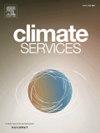Spatiotemporal characteristics of drought in the Tarim River Basin from 2000 to 2022 based on the SPEI
IF 4.5
3区 环境科学与生态学
Q2 ENVIRONMENTAL SCIENCES
引用次数: 0
Abstract
This study used the Thornthwaite method to calculate SPEI. The characteristics of spatiotemporal variations of temperature, precipitation, SPEI, and drought variables were analyzed using methods such as climate inclination rate. The study found that: (1) Spring temperature and growing season precipitation show increase of 0.4 °C and 9.2 mm for every ten years, respectively. The temperature inclination rate gradually increases from the eastern to central regions, while the precipitation inclination rate gradually increases from the southern to northern regions. The SPEI inclination rate gradually increases from the southwest to the northeast. (2) There are differences in abrupt change points in temperature, precipitation, and SPEI, the years of abrupt change points in annual temperature, annual precipitation, and SPEI-12 were 2010, 2015, and 2016, respectively. (3) Light drought occurs in the northeast and western regions, moderate drought in the central and southern regions, severe drought in the eastern and central western regions, and extreme drought in the northeast regions. (4) The drought intensity increases throughout the year and in spring, with an increase of 0.04 and 0.18 for every ten years, respectively, while it decreases during summer, autumn, and growing season, with a decrease of 0.18, 0.14 and 0.03 for every ten years, respectively. The drought intensity throughout the year and in each season is mainly light. The study contributes to a deeper understanding of the spatiotemporal characteristics of drought in the Tarim River Basin.
基于SPEI的2000 - 2022年塔里木河流域干旱时空特征
本研究采用Thornthwaite方法计算SPEI。利用气候倾斜率等方法分析了温度、降水、SPEI和干旱等变量的时空变化特征。研究发现:(1)春季气温和生长期降水每10年分别增加0.4°C和9.2 mm。气温倾向率从东部到中部逐渐增大,降水倾向率从南部到北部逐渐增大。SPEI倾斜率由西南向东北逐渐增大。(2)气温、降水和SPEI的突变点存在差异,年气温、年降水和SPEI-12的突变点年份分别为2010年、2015年和2016年。③东北和西部地区为轻度干旱,中部和南部地区为中度干旱,东部和中西部地区为重度干旱,东北部地区为极端干旱。(4)干旱强度在全年和春季呈增加趋势,每10年分别增加0.04和0.18,在夏季、秋季和生长期呈减少趋势,每10年分别减少0.18、0.14和0.03。全年和各季节干旱强度以轻度为主。该研究有助于加深对塔里木河流域干旱时空特征的认识。
本文章由计算机程序翻译,如有差异,请以英文原文为准。
求助全文
约1分钟内获得全文
求助全文
来源期刊

Climate Services
Multiple-
CiteScore
5.30
自引率
15.60%
发文量
62
期刊介绍:
The journal Climate Services publishes research with a focus on science-based and user-specific climate information underpinning climate services, ultimately to assist society to adapt to climate change. Climate Services brings science and practice closer together. The journal addresses both researchers in the field of climate service research, and stakeholders and practitioners interested in or already applying climate services. It serves as a means of communication, dialogue and exchange between researchers and stakeholders. Climate services pioneers novel research areas that directly refer to how climate information can be applied in methodologies and tools for adaptation to climate change. It publishes best practice examples, case studies as well as theories, methods and data analysis with a clear connection to climate services. The focus of the published work is often multi-disciplinary, case-specific, tailored to specific sectors and strongly application-oriented. To offer a suitable outlet for such studies, Climate Services journal introduced a new section in the research article type. The research article contains a classical scientific part as well as a section with easily understandable practical implications for policy makers and practitioners. The journal''s focus is on the use and usability of climate information for adaptation purposes underpinning climate services.
 求助内容:
求助内容: 应助结果提醒方式:
应助结果提醒方式:


